 IST,
IST,


Address of Dr. (Smt.) Deepali Pant Joshi, Executive Director, Reserve Bank of India at National Seminar on Consumer Protection - Agenda for Inclusive Growth, New Delhi on July 24, 2013
Dr. (Smt.) Deepali Pant Joshi, Executive Director, Reserve Bank of India
delivered-on ਜੁਲਾ 24, 2013
I congratulate Assocham on the timely initiative of hosting this event and bringing to the centre stage of debate very critical issues as customer Empowerment and Financial Inclusion. The “post crisis” world is governed by a new paradigm of customer empowerment. The financial crisis has highlighted the importance of financial consumer protection for the long-term stability of the global financial system. Rapid increase in the use of financial services brings into sharp salience the need for strengthened financial regulation and consumer education to protect and empower consumers. Consumer empowerment is a central goal. Education of consumers through information disclosure or through consumer literacy is utilized as a means to even out asymmetries of bargaining power between consumers and financial services providers. In the area of consumer credit and financial literacy, investment empowerment relies on the consumers’ ability to understand complex financial products and their knowledge and experience of using such products and services. All financial products contain risks and also offer rewards. Financially literate consumers are individuals who are equipped to assess risks and to make informed decisions about the suitability of financial products to their situation. There are differences between individual consumers. This granularity arises due to the differences in incomes of consumers. The largest issue to be tackled is an asymmetry of bargaining power between the financial services provider and the consumer of services. The consumers are always the weaker parties in need of protection. Consumers need to be enabled to navigate the financial markets to make choices beneficial to their needs. They should be able to understand complex financial products and should be equipped with the knowledge and skills to assess risks and make informed decisions about the suitability of financial products to their situation. A well-functioning consumer protection regime provides effective safeguards for retail financial services consumers while empowering consumers to exercise their legal rights and fulfill their legal obligations. The Banking Ombudsman Scheme provides clear consumer protection rules with regard to banking products and services. The necessary institutional arrangement for grievance redress is in place. However, these rules need objective, timely and fair implementation. All these three aspects are important. BCSBI has also developed codes of conduct and these codes are widely publicized and expected to be adhered to. Dispute resolution mechanisms to be effectively utilized require financial literacy of consumers and this is the process of consumer empowerment which alone can ensure financial inclusion. Financial Inclusion and inclusive growth Financial exclusion is a barrier to attaining a high growth rate it should be the unremitting endeavour to draw the excluded into the pale of mainstream financial institutions A developed financial system broadens access to funds and banking facilities conversely in an underdeveloped financial system high cost informal sources as moneylenders proliferate. Lower the availability of funds and higher their cost fewer are the economic activities that can be financed and hence lower the resulting economic growth. Today we are painfully aware that there are a vast number of unreached people excluded from formal financial services Potential entrepreneurs small enterprises fail to grow and prosper due to capital constraints .Financial deepening is thus a necessary for economic growth as Dr Manmohan Singh has explained The goal of the development process is to include every last member of our society especially those at the margins This not only broadens the support base for development it also strengthens the ability to perform the core developmental goal Extent of Financial Exclusion in India Let us be clear as to the enormity of the challenge half of the country is unbanked Thirty four years after bank nationalisation and extensive bank branch building 6 lakh villages in India, rural branches of SCBs including RRBs number 33,495. Post Nationalization, number of bank branches of scheduled commercial banks increased Starting with 1990s the focus shifted to strengthening financial institutions as part of financial sector reforms. Number of rural branches actually came down in the decade of the nineties leading in the middle of the next decade to critical concerns on inclusion. POPULATION GROUP-WISE NUMBER OF BRANCHES OF SCHEDULED COMMERCIAL BANKS
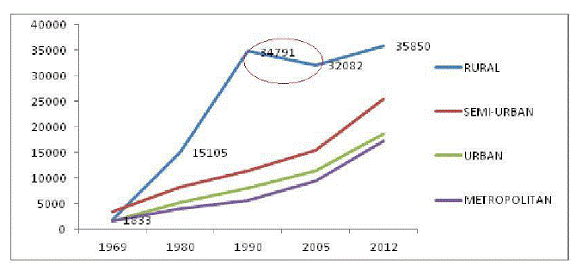 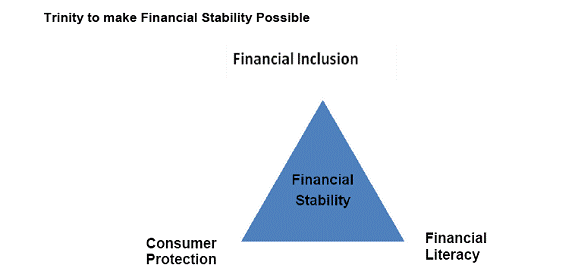 Financial Inclusion and inclusive growth Inclusive growth allows people to ‘contribute to and benefit from economic growth’. Bank led Model Keeping in view the existing infrastructure of bank branches in India, we have adopted a bank- led model for financial inclusion which leverages technology for optimisation of results. The FI initiatives are ICT enabled and ride on new delivery models be customised by market participants to best suit their requirements. The development of the habit of banking would lead to an increase in savings and investment improve the efficiency of allocation of capital and increase the ability of monetary authorities to stabilise the economy in times of crisis Our experience shows that the goal of financial inclusion is better served through mainstream banking institutions as only they have the ability to offer the suite of products required to bring in effective/meaningful financial inclusion.A well functioning financial system creates necessary conditions for more rapid economic growth so that there is a positive correlation between economic growth and the financial system. Minimum bouquet of products and services To meet the criterion of availability of banking services, a minimum of four basic products must be offered to customers:
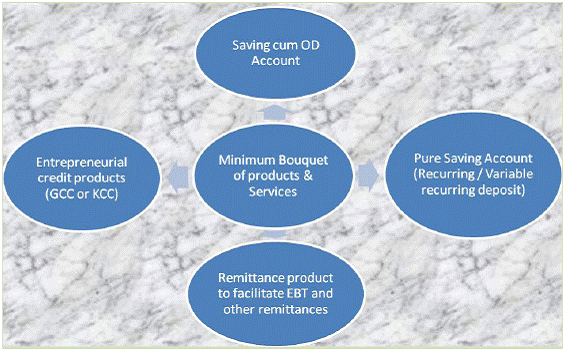 Since size of population and the distribution foot print of bank branches are not enough to cater each and every person in the country; to increase number of bank branches through FIP following initiatives were taken: Relaxed regulatory requirements i. Relaxed regulatory dispensation on KYC norms: Know Your Customer (KYC) requirements for opening bank accounts have been relaxed and simplified, especially for small accounts with balances not exceeding Rs. 50,000/- and aggregate credits in the accounts not exceeding Rs. one lakh a year. In modification to the earlier guidelines on KYC norms, RBI has now advised banks not to insist on introduction for opening bank accounts of customers. In addition to this RBI has now allowed banks to use Aadhaar Card as a proof of both identity and address and the MNREGA Job Card as an officially valid document for opening of bank accounts. ii. Mandatory requirement for opening branches in unbanked villages: To further step up the opening of branches in rural areas so as to improve banking penetration and financial inclusion rapidly, the need for opening of more brick and mortar branches, besides the use of BCs, was felt. Accordingly, domestic SCBs have been mandated in the Monetary Policy Statement – April 2011 to allocate at least 25 per cent of the total number of branches to be opened during a year in unbanked rural (Tier 5 and Tier 6) centres.There are few studies on the impact of bank branches and development In 2003 Burgess and Pande examined the branch expansion policy of commercial banks implemented post nationalisation From 1990 to 1997 the RBI branch authorisation policies specified that banks could establish a new bank branch in a location with one or more bank branches only if they set up four branches in a location with no new bank branches This regulatory prescription ensured that banks opened rural branches in states where financial development was lower to address the regional inequities in development.Their results to evaluate the impact of a new rural branch on poverty suggested that a one percent increase in the number of banks in rural locations reduced rural poverty by 0.36% per cent and increased total output by 0.55% per cent Rural branch expansion also increased non primary sector output and non agricultural employment. These favourable effects show the positive influence of bank branches on economic development Banks to the 1990s disbursed a greater share of credit to the less developed states this trend reversed after the 1990s. iii. In the Annual Policy Statement for 2013-14, banks have been advised to consider frontloading (prioritizing) the opening of branches in unbanked rural centres over a three year cycle co-terminus with their FIPs. This is expected to facilitate faster branch expansion in unbanked rural centres. “STEP INTO A BANK STEP OUT OF POVERTY IS OUR CENTRAL MESSAGE”  iv. Business Correspondent/ Business Facilitator Model In January 2006, the Reserve Bank permitted banks to utilise the services of non-governmental organizations (NGOs), micro-finance institutions (other than Non-Banking Financial Companies) and other civil society organisations as intermediaries in providing financial and banking services through the use of business facilitator and business correspondent (BC) models. The BC model allows banks to do ‘cash in - cash out’ transactions at a location much closer to the rural population, thus addressing the last mile problem. As on March 31 2013, banks have reported deploying 1,95,380 BCs which covered 2,21,341 villages. v. Introducing Technology To ensure sustainability and scalability of business model, technology was adopted. It leads to higher costs at initial stage however; it brings better opportunities and optimization of result. The UID is also good instrument of connecting to all the people once it gets effectively operational. vi. The Direct Benefit Transfer scheme and the Adhar number are going to be very significant in the years to come the RBI has accepted Adhaar as a proof of identity and as fulfilling KYC requirements 1st of January, 2013. Nearly 11 lakh beneficiaries have received the benefit directly into their bank accounts. Financial Inclusion Plans of banks for 3 years: RBI in January 2010 had advised all public and private sector banks to submit a Board approved three-year Financial Inclusion Plan (FIP) starting April 2010. Banks were advised to devise FIPs congruent with their business strategy and comparative advantage to make it an integral part of their corporate plans. These plans broadly included self-set targets in respect of rural brick and mortar branches opened, BCs employed, coverage of unbanked villages with population above 2000 as also other unbanked villages with population below 2000 through branches/BCs/other modes, no-frills accounts opened including through BC-ICT, Kisan Credit Cards (KCC) and General Credit Cards (GCC) issued, and other specific products designed by them to cater to the financially excluded segments.Banks were advised to integrate Board-approved FIPs with their business plans and to include the criteria on financial inclusion as a parameter in the performance evaluation of their staff. The implementation of these plans was closely monitored by the Reserve Bank on a monthly basis through a quantitative reporting format. Qualitative aspect under FIP was monitored through a qualitative report submitted by banks on quarterly basis. A snapshot of the progress made by banks under the 3 year Financial Inclusion Plan (April 10 - March 13) for key parameters during the three year period is given below:- 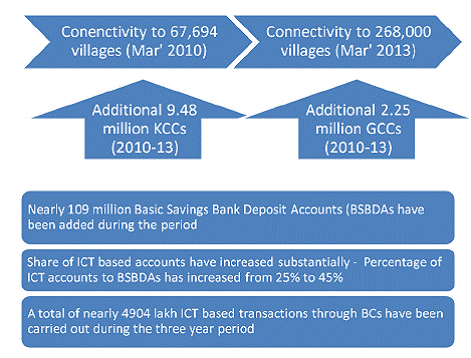 Challenges in Financial Inclusion
New banks New banks are expected bring sustainable business models, bring innovation in banking products and services and improve penetration of banking activities. We need new banks to bring new business models and not for derivative products and investment banking. At mezzanine finance level, Banks also need sensitivity to default rates. They require an estimation of extent of losses, loss given default our message is that Financial Inclusion should be viewed nether from the prophet or the profit motive but as a pragmatic business opportunity by the Banks .I would do well to sum up with Dr P Chidambarams enunciation Dr Chidambaram.stated The reforms since 1991 have changed the face of the Indian economy India is slowly but surely being recognised. Economic reforms have led to a sharp decline in people below the poverty line sustainability of the reform process demands that all sections of society stand to gain from it only if the poorer sections of society also perceive a visible change in quality of their life will the reform process continue in our vibrant democracy.I thank you for a patient hearing and wish your deliberations all success. ANNEX 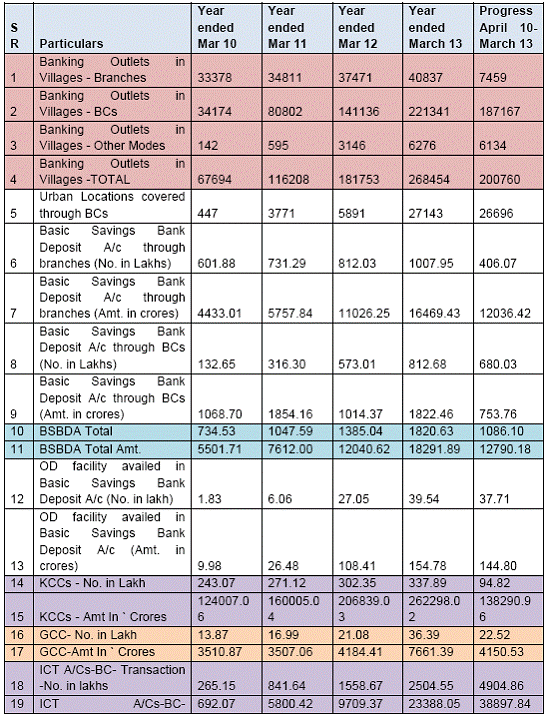 1. Progress in Modes of FI delivery 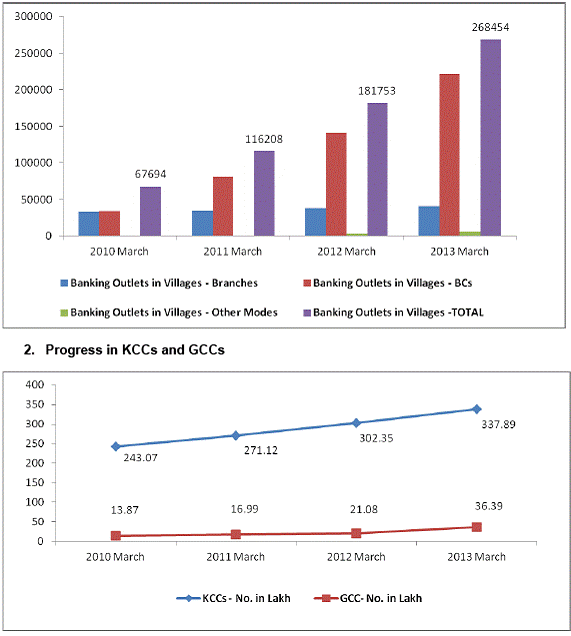 3. Progress in number of Accounts 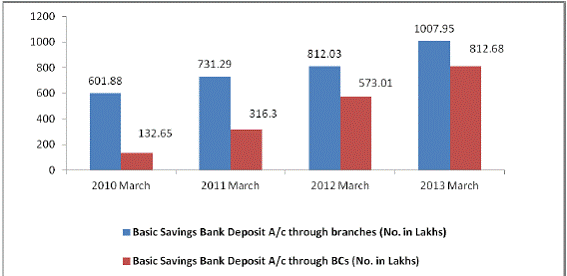 4. Progress in O/D facility availed 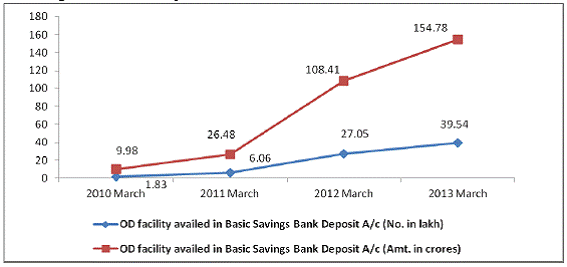 Thanks to Smt. Sonali Sengupta, General Manager for presenting the speech at ASSOCHAM, New Delhi. Assistance rendered by Mr. Bipin Nair, Assistant General Manager, Smt. Mruga Paranjape, Manager is gratefully acknowledged. |
ਪੇਜ ਅੰਤਿਮ ਅੱਪਡੇਟ ਦੀ ਤਾਰੀਖ:

















